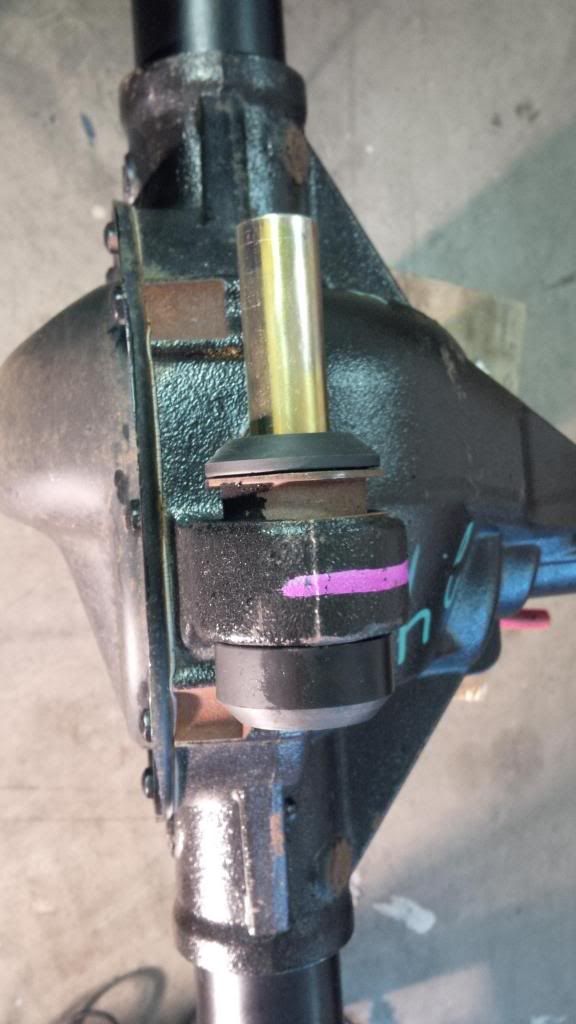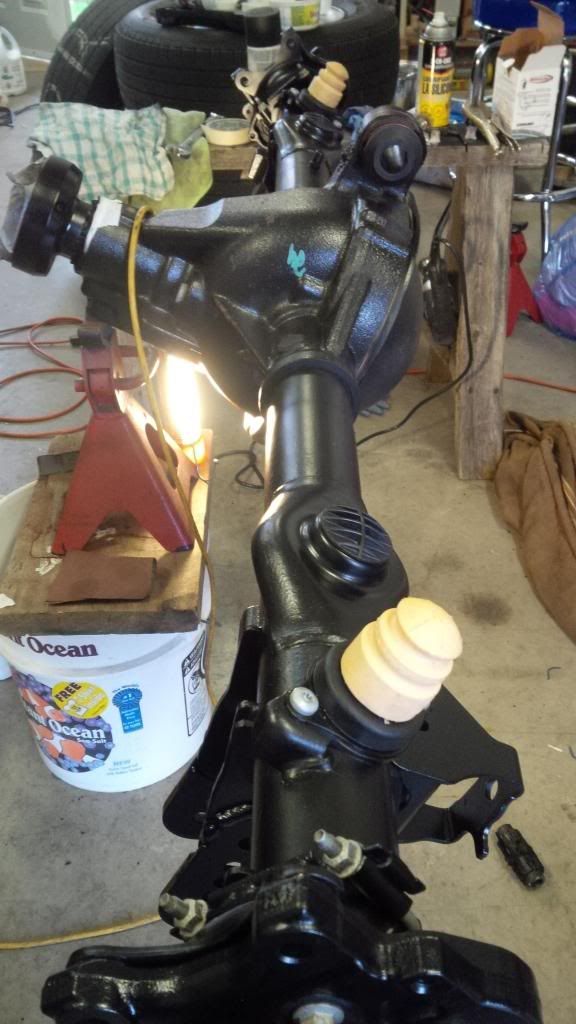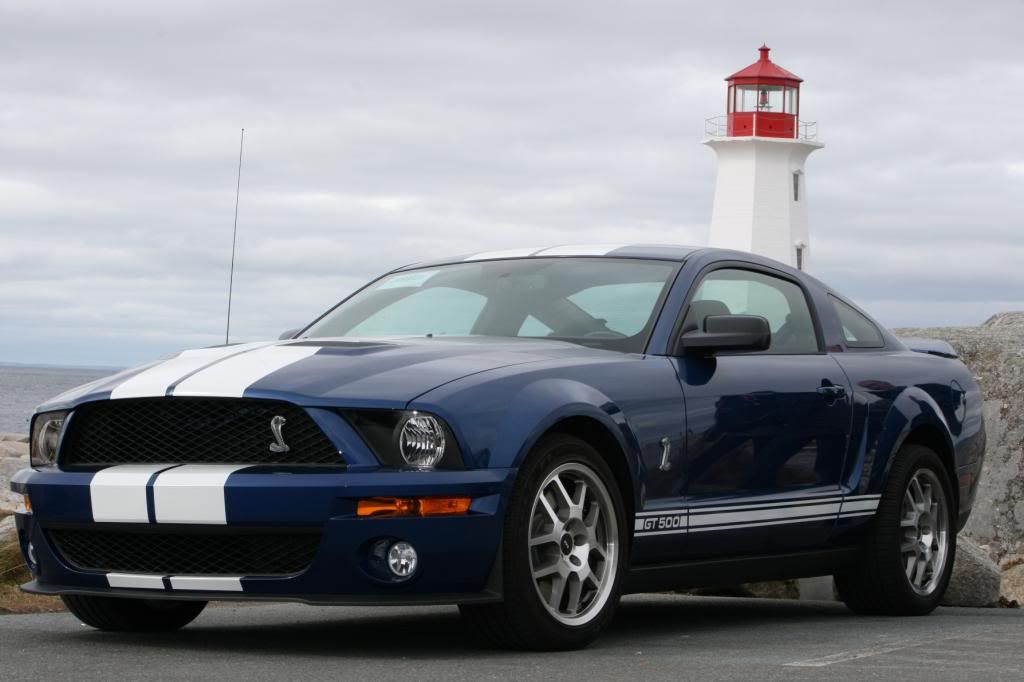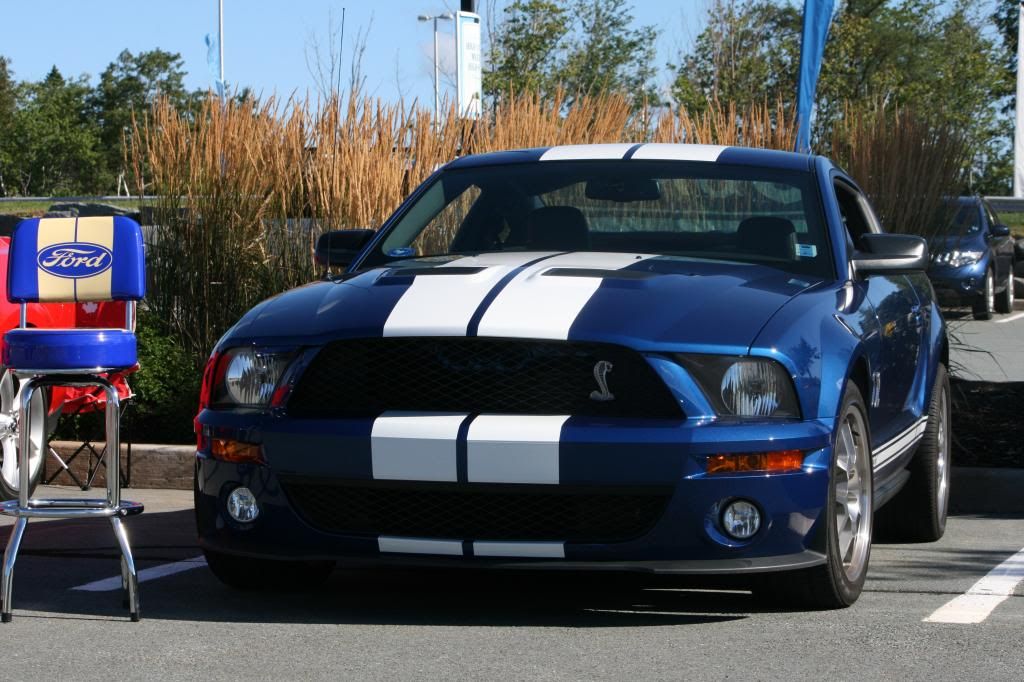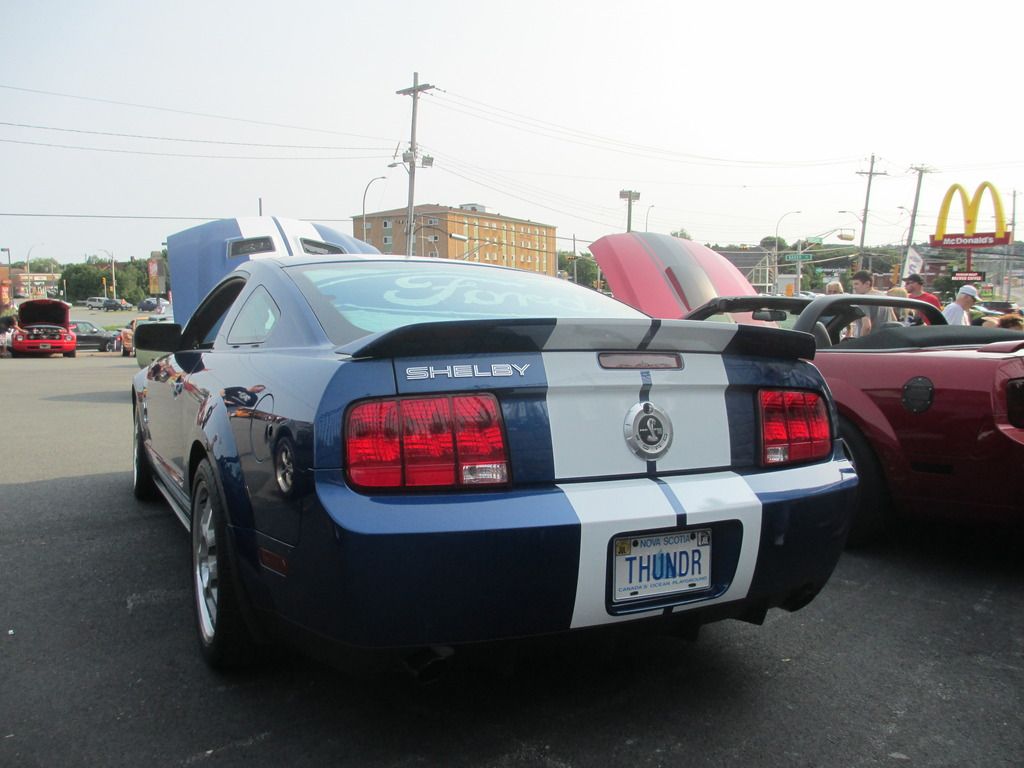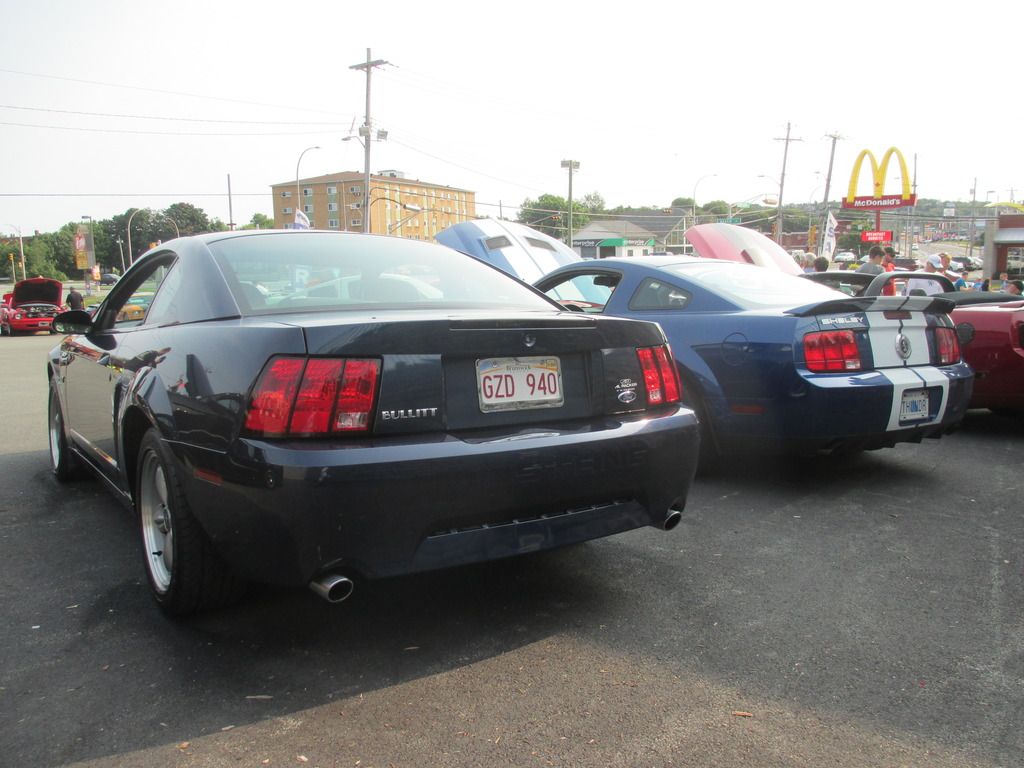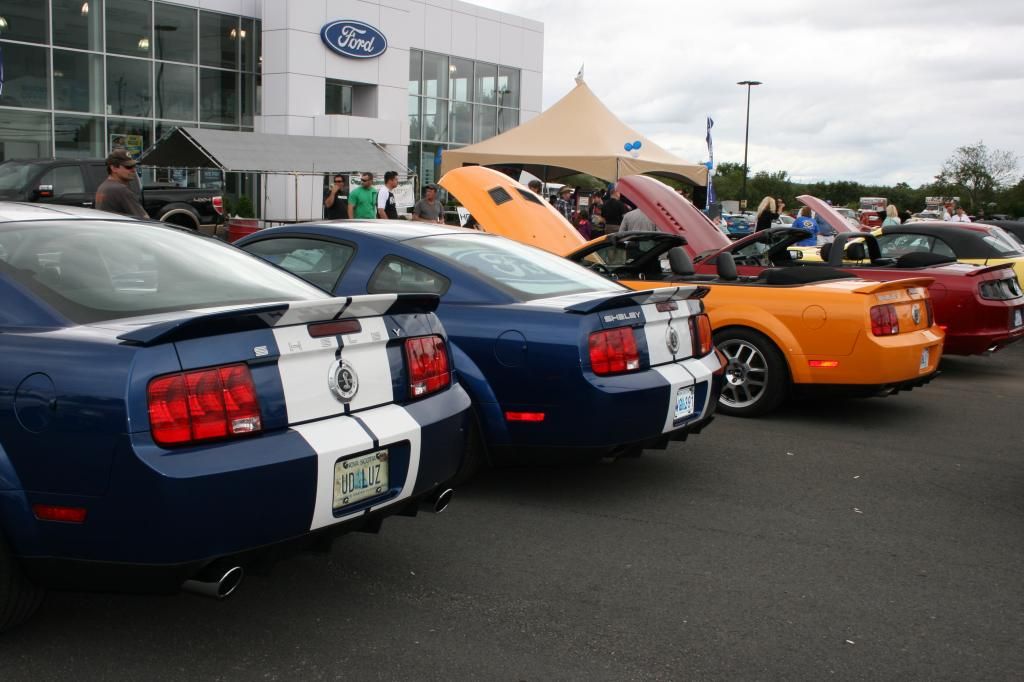You are using an out of date browser. It may not display this or other websites correctly.
You should upgrade or use an alternative browser.
You should upgrade or use an alternative browser.
2008 Vista Blue GT500
- Thread starter thundr
- Start date
TrueBlue02058
Post King
thundr
Well-known member
[h=2]2007-2009 Ford Shelby SVT GT-500 Specifications[/h] See Photos: 2007 Shelby GT-500 Photo Gallery
As published by Ford Motor Company
BODY
Construction: Unitized welded steel body, aluminum hood
POWERTRAIN AND CHASSIS
ENGINE
Type: V-8
Manufacturing location: Romeo, Michigan
Configuration: Iron Block and Aluminum Heads
Intake manifold: Cast-aluminum with Roots-type supercharger and air-to-water intercooler
Exhaust manifold: Cast iron
Crankshaft: Forged steel
Throttle Body: Dual 60 mm, electronic
Valvetrain: DOHC, 4 valves per cylinder
Valve diameter: Intake: 37.0 mm; Exhaust: 32.0 mm
Pistons: Forged aluminum
Connecting Rods: Cracked forged steel I-beams
Ignition: Coil-on-plug
Bore x stroke: 3.552 x 4.165 in. / 90.22 x 105.8 mm
Displacement: 330 cu. in. / 5,409 cc
Horsepower: 500 hp @ 6000 rpm
Torque: 480 lb-ft @ 4500 rpm
Compression ratio: 8.4:1
Redline: 6,250 rpm
Idle Speed in Neutral: 750 rpm
Engine control system: Spanish oak PCM
Recommended fuel: Premium only
Fuel capacity: 16.0 gallons
Fuel Injection: Electronic returnless sequential
Oil capacity: 6.5 quarts 5W-50 Full Synthetic
Coolant capacity: 21 quarts
DRIVETRAIN
Layout: Rear-wheel drive
TRANSMISSION
Standard (Type): Tremec TR6060 6-speed manual
Gear Ratios:
1st: 2.97
2nd: 1.78
3rd: 1.3
4th: 1.0
5th: 0.80
6th: 0.63
Final Drive: 3.31
SUSPENSION
Front: Reverse-L independent MacPherson strut, 34-mm tubular stabilizer bar
Rear: Three-link solid axle with coil springs, Panhard rod, 24-mm solid stabilizer bar
STEERING
Type: Rack and pinion with power assist
Ratio: 15.7:1
Steering column: Tilt
BRAKES
Type: Four wheel power disc with 4-channel anti-lock braking system ( ABS ), electronic brake force distribution (EBD) and traction control
Front: Brembo 14-inch diameter vented discs, four-piston aluminum calipers
Rear: 11.8-inch diameter vented discs, two-piston calipers
TIRES AND WHEELS
Tires: P255/45R18 front tires, P285/40ZR18 rear tires
Wheels: 18 x 9.5-in machined aluminum wheels with SVT center caps
FUEL ECONOMY (city/hwy)
5.4L V8 6-Spd. Manual: 15/21
DIMENSIONS (inches unless otherwise noted) (All dimensions are Preliminary)\
EXTERIOR
Wheelbase: 107.1 in.
Overall length: 188.0 in.
Overall width: 73.9 in.
Overall height: 54.5 in., Coupe; 55.7 in., Convertible
Track width, front/rear: 61.9 in. / 62.5 in.
Ground clearance: 5.71 in.
INTERIOR
Seating capacity: 4 passenger
Headroom: Front row 38.6 in., Coupe; 38.8 in., Convertible Second row: 35.0 in., Coupe; 36.3 in., Convertible: Legroom Front row 42.7 in., Coupe; 42.7 in., Convertible Second row 31.0 in., Coupe; 30.3 in., Convertible
Shoulder room: Front row 55.4 in., Coupe; 55.4 in., Convertible Second row 53.3 in., Coupe; 45.0 in., Convertible
Hip room: Front row 53.6 in., Coupe; 53.6 in., Convertible Second row 46.7 in., Coupe; 45.4 in., Convertible
Cargo Volume: 12.3 cu. ft., Coupe; 9.7 cu. ft., Convertible
WEIGHTS AND CAPACITIES (pounds unless otherwise noted)
Curb weight, pounds: Coupe ~3,920 pounds, Convertible ~4,040 pounds
Weight distribution (f/r) 57/43
SAFETY
Safety belts: Load-limiting seat belts with pretensioners and height-adjustable shoulder belts for front seating positions (coupe) Three-point safety belts for all seating positions BeltMinder™ safety-belt reminder chime
Air bags: Dual-stage driver and front-passenger air bags with crash-severity sensor, driver-seat-position sensor and front-passenger weight sensor Seat-deployed side air bags for driver and front passenger
Child safety: LATCH anchors for rear outboard seats
Brakes: Anti-lock braking system ( ABS )Traction-control system
Fuel: Inertia-activated shutoff switch for fuel pump
Security: SecuriLock™ passive anti-theft system
Remote keyless entry: Separate alarm sounder
Anti-tow sensor: Ultrasonic interior motion sensor
Perimeter anti-theft battery
MAJOR STANDARD EQUIPMENT
Audio system: Shaker 500: AM/FM stereo with six-disc CD/MP3 capable player with eight speakers
EXTERIOR
Badging: Unique GT500
Top: Black cloth (Convertible only)
Exhaust: Tuned dual stainless steel
Fascia: Unique GT500 color-keyed front and rear
Fog lamps: Front
Grille: Unique upper with Cobra emblem
Hood: Unique with heat extractors
Locking: Remote keyless entry
Spoiler: Unique color-keyed decklid spoiler
Trim: Over-the-top “LeMans” stripes and “GT500″ side stripes (Coupe)
“GT500″ side stripes (Convertible)
Trunk: “Fix a Flat” tire repair kit
INTERIOR
Air conditioning: Manual
Console: Center with full armrest and storage
Cupholders: 2
Door trim inserts: Soft vinyl
Floor mats: Front, color-keyed with driver-side retention hook
Instrument cluster: Includes boost gauge and message center, SVT graphics
Map pockets: Front doors
Power points: 2
Scuff plates: Door sills, with bright SVT script insert
Seats: Leather sport buckets; 6-way power adjustable driver seat with power lumbar and 2-way adjustable head restraint
Shift knob: Unique with leather shift boot and parking brake handle
Steering wheel: Leather-wrapped with unique thumb pads, adjustable for tilt
Windows/door locks: Power
OPTIONS
DELETE OPTIONS
“LeMans” stripes: Coupe only
“GT500″ side stripes: Coupe, Convertible
AUDIO
Shaker 1000: 1000 watt audio system: AM/FM stereo, in-dash six-disc CD/MP3 player, 10 speakers
Satellite radio: SIRIUS
PACKAGE
GT500 Premium Interior Trim Package: Wrapped and stitched instrument panel brow and center condole with upgraded door armrest, electrochromic rearview mirror and aluminum pedal covers
EXTERIOR/INTERIOR COLORS
EXTERIOR
Paint/stripe colors:
Torch Red Clearcoat with Performance White or Satin Silver stripes
Alloy Clearcoat Metallic with Satin Silver or Tungsten stripes
Vista Blue Clearcoat with Performance White or Tungsten stripes
Performance White Clearcoat with Vista Blue or Tungsten stripes
Tungsten Grey Clearcoat with Satin Silver stripes
Valencia Yellow Clearcoat with Tungsten stripes
Ebony Clearcoat with Performance White or Tungsten stripes
Convertible top: Black cloth
INTERIOR
Charcoal Black/Charcoal Black
Charcoal Black/Crimson Red
WARRANTY INFORMATION
Warranty
3-year, 36,000-mile bumper-to-bumper limited warranty
5-year, 60,000-mile powertrain limited warranty and roadside assistance
As published by Ford Motor Company
BODY
Construction: Unitized welded steel body, aluminum hood
POWERTRAIN AND CHASSIS
ENGINE
Type: V-8
Manufacturing location: Romeo, Michigan
Configuration: Iron Block and Aluminum Heads
Intake manifold: Cast-aluminum with Roots-type supercharger and air-to-water intercooler
Exhaust manifold: Cast iron
Crankshaft: Forged steel
Throttle Body: Dual 60 mm, electronic
Valvetrain: DOHC, 4 valves per cylinder
Valve diameter: Intake: 37.0 mm; Exhaust: 32.0 mm
Pistons: Forged aluminum
Connecting Rods: Cracked forged steel I-beams
Ignition: Coil-on-plug
Bore x stroke: 3.552 x 4.165 in. / 90.22 x 105.8 mm
Displacement: 330 cu. in. / 5,409 cc
Horsepower: 500 hp @ 6000 rpm
Torque: 480 lb-ft @ 4500 rpm
Compression ratio: 8.4:1
Redline: 6,250 rpm
Idle Speed in Neutral: 750 rpm
Engine control system: Spanish oak PCM
Recommended fuel: Premium only
Fuel capacity: 16.0 gallons
Fuel Injection: Electronic returnless sequential
Oil capacity: 6.5 quarts 5W-50 Full Synthetic
Coolant capacity: 21 quarts
DRIVETRAIN
Layout: Rear-wheel drive
TRANSMISSION
Standard (Type): Tremec TR6060 6-speed manual
Gear Ratios:
1st: 2.97
2nd: 1.78
3rd: 1.3
4th: 1.0
5th: 0.80
6th: 0.63
Final Drive: 3.31
SUSPENSION
Front: Reverse-L independent MacPherson strut, 34-mm tubular stabilizer bar
Rear: Three-link solid axle with coil springs, Panhard rod, 24-mm solid stabilizer bar
STEERING
Type: Rack and pinion with power assist
Ratio: 15.7:1
Steering column: Tilt
BRAKES
Type: Four wheel power disc with 4-channel anti-lock braking system ( ABS ), electronic brake force distribution (EBD) and traction control
Front: Brembo 14-inch diameter vented discs, four-piston aluminum calipers
Rear: 11.8-inch diameter vented discs, two-piston calipers
TIRES AND WHEELS
Tires: P255/45R18 front tires, P285/40ZR18 rear tires
Wheels: 18 x 9.5-in machined aluminum wheels with SVT center caps
FUEL ECONOMY (city/hwy)
5.4L V8 6-Spd. Manual: 15/21
DIMENSIONS (inches unless otherwise noted) (All dimensions are Preliminary)\
EXTERIOR
Wheelbase: 107.1 in.
Overall length: 188.0 in.
Overall width: 73.9 in.
Overall height: 54.5 in., Coupe; 55.7 in., Convertible
Track width, front/rear: 61.9 in. / 62.5 in.
Ground clearance: 5.71 in.
INTERIOR
Seating capacity: 4 passenger
Headroom: Front row 38.6 in., Coupe; 38.8 in., Convertible Second row: 35.0 in., Coupe; 36.3 in., Convertible: Legroom Front row 42.7 in., Coupe; 42.7 in., Convertible Second row 31.0 in., Coupe; 30.3 in., Convertible
Shoulder room: Front row 55.4 in., Coupe; 55.4 in., Convertible Second row 53.3 in., Coupe; 45.0 in., Convertible
Hip room: Front row 53.6 in., Coupe; 53.6 in., Convertible Second row 46.7 in., Coupe; 45.4 in., Convertible
Cargo Volume: 12.3 cu. ft., Coupe; 9.7 cu. ft., Convertible
WEIGHTS AND CAPACITIES (pounds unless otherwise noted)
Curb weight, pounds: Coupe ~3,920 pounds, Convertible ~4,040 pounds
Weight distribution (f/r) 57/43
SAFETY
Safety belts: Load-limiting seat belts with pretensioners and height-adjustable shoulder belts for front seating positions (coupe) Three-point safety belts for all seating positions BeltMinder™ safety-belt reminder chime
Air bags: Dual-stage driver and front-passenger air bags with crash-severity sensor, driver-seat-position sensor and front-passenger weight sensor Seat-deployed side air bags for driver and front passenger
Child safety: LATCH anchors for rear outboard seats
Brakes: Anti-lock braking system ( ABS )Traction-control system
Fuel: Inertia-activated shutoff switch for fuel pump
Security: SecuriLock™ passive anti-theft system
Remote keyless entry: Separate alarm sounder
Anti-tow sensor: Ultrasonic interior motion sensor
Perimeter anti-theft battery
MAJOR STANDARD EQUIPMENT
Audio system: Shaker 500: AM/FM stereo with six-disc CD/MP3 capable player with eight speakers
EXTERIOR
Badging: Unique GT500
Top: Black cloth (Convertible only)
Exhaust: Tuned dual stainless steel
Fascia: Unique GT500 color-keyed front and rear
Fog lamps: Front
Grille: Unique upper with Cobra emblem
Hood: Unique with heat extractors
Locking: Remote keyless entry
Spoiler: Unique color-keyed decklid spoiler
Trim: Over-the-top “LeMans” stripes and “GT500″ side stripes (Coupe)
“GT500″ side stripes (Convertible)
Trunk: “Fix a Flat” tire repair kit
INTERIOR
Air conditioning: Manual
Console: Center with full armrest and storage
Cupholders: 2
Door trim inserts: Soft vinyl
Floor mats: Front, color-keyed with driver-side retention hook
Instrument cluster: Includes boost gauge and message center, SVT graphics
Map pockets: Front doors
Power points: 2
Scuff plates: Door sills, with bright SVT script insert
Seats: Leather sport buckets; 6-way power adjustable driver seat with power lumbar and 2-way adjustable head restraint
Shift knob: Unique with leather shift boot and parking brake handle
Steering wheel: Leather-wrapped with unique thumb pads, adjustable for tilt
Windows/door locks: Power
OPTIONS
DELETE OPTIONS
“LeMans” stripes: Coupe only
“GT500″ side stripes: Coupe, Convertible
AUDIO
Shaker 1000: 1000 watt audio system: AM/FM stereo, in-dash six-disc CD/MP3 player, 10 speakers
Satellite radio: SIRIUS
PACKAGE
GT500 Premium Interior Trim Package: Wrapped and stitched instrument panel brow and center condole with upgraded door armrest, electrochromic rearview mirror and aluminum pedal covers
EXTERIOR/INTERIOR COLORS
EXTERIOR
Paint/stripe colors:
Torch Red Clearcoat with Performance White or Satin Silver stripes
Alloy Clearcoat Metallic with Satin Silver or Tungsten stripes
Vista Blue Clearcoat with Performance White or Tungsten stripes
Performance White Clearcoat with Vista Blue or Tungsten stripes
Tungsten Grey Clearcoat with Satin Silver stripes
Valencia Yellow Clearcoat with Tungsten stripes
Ebony Clearcoat with Performance White or Tungsten stripes
Convertible top: Black cloth
INTERIOR
Charcoal Black/Charcoal Black
Charcoal Black/Crimson Red
WARRANTY INFORMATION
Warranty
3-year, 36,000-mile bumper-to-bumper limited warranty
5-year, 60,000-mile powertrain limited warranty and roadside assistance
thundr
Well-known member
| Total Production - 8,583 | ||||||||||||||||||||||||||||||||||||||||||||||||||||||||||||||||||||||||||||||||||||||||||
| Source: Thanks Bill Novosad for tracking down the numbers... | ||||||||||||||||||||||||||||||||||||||||||||||||||||||||||||||||||||||||||||||||||||||||||
| 2008 Shelby GT500 Coupe: Interior & Exterior | ||||||||||||||||||||||||||||||||||||||||||||||||||||||||||||||||||||||||||||||||||||||||||
| ||||||||||||||||||||||||||||||||||||||||||||||||||||||||||||||||||||||||||||||||||||||||||
| 2008 Shelby GT500 Convertible: Interior & Exterior | ||||||||||||||||||||||||||||||||||||||||||||||||||||||||||||||||||||||||||||||||||||||||||
| ||||||||||||||||||||||||||||||||||||||||||||||||||||||||||||||||||||||||||||||||||||||||||
| Red Stripe Breakdown: Allready Included in Coupe Numbers above | ||||||||||||||||||||||||||||||||||||||||||||||||||||||||||||||||||||||||||||||||||||||||||
| ||||||||||||||||||||||||||||||||||||||||||||||||||||||||||||||||||||||||||||||||||||||||||
| 2008 Shelby GT500 Stripe & Exterior Color - Coupe | ||||||||||||||||||||||||||||||||||||||||||||||||||||||||||||||||||||||||||||||||||||||||||
| ||||||||||||||||||||||||||||||||||||||||||||||||||||||||||||||||||||||||||||||||||||||||||
| 2008 Shelby GT500 Stripe & Exterior Color - Convertible | ||||||||||||||||||||||||||||||||||||||||||||||||||||||||||||||||||||||||||||||||||||||||||
| ||||||||||||||||||||||||||||||||||||||||||||||||||||||||||||||||||||||||||||||||||||||||||
| *All convertible tops were Black |
thundr
Well-known member
My car is completely stock except for the various suspension mods. I started with the UCA and LCAs first just to correct the wicked wheel hop.
There are a number of manufacturers out there including BMR which I consider good products. I choose the Steeda since they have a race heritage and they had some features I wanted.
I have the competition UCA which is essentially longer for better geometry under load. It has the poly end bushing. I looked at the spherical ends in both metal and Teflon, but decided not to go with those. I did not want the metal due to the harshness and on going maintenance. I thought the Teflon to be too weak.
At the time when I changed out the control arms I did not change the axle housing bushing. My thought was this would keep things quieter and give some compliance to the UCA and allow the suspension to roll with out binding. I think that worked, but I had a very slight clunk when at low speed when on and off the throttle.
On the lower control arms I did go with the alum for the bling factor. I opted for the poly on one end and Teflon heim joint on the other. Again for the non binding features.
The mods did not really give me any notice ride noise, mainly because of the poly bushings on at least one end of the arms. And wheel hop was gone. That was my main objective.
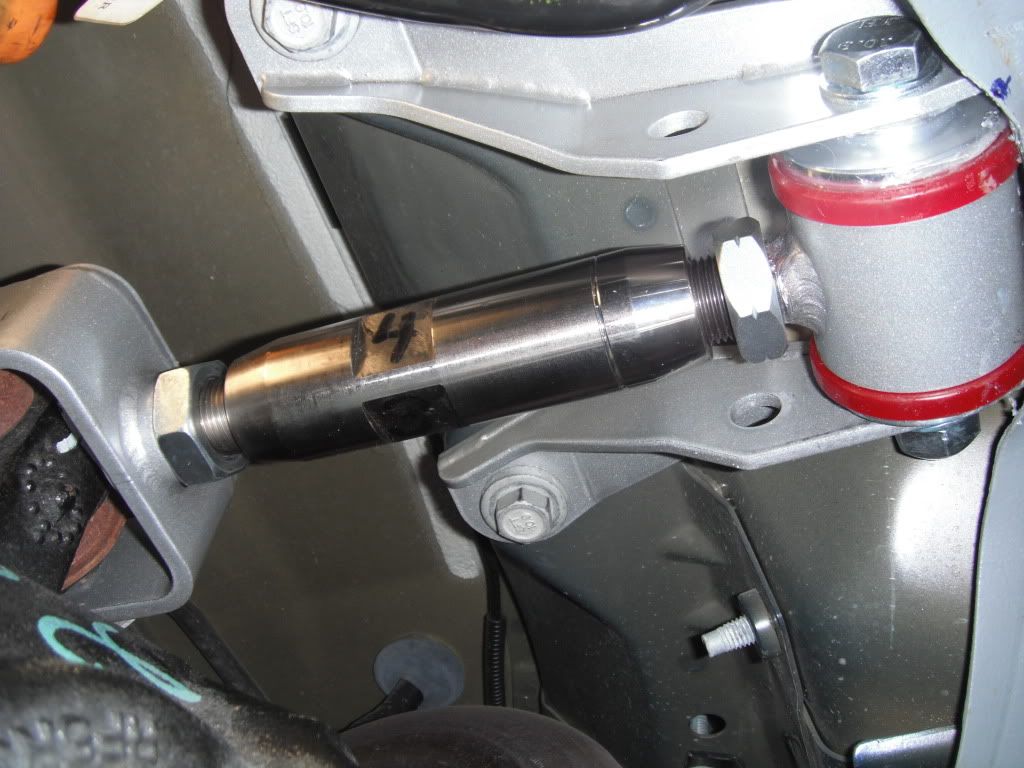
New and old, longer UCA
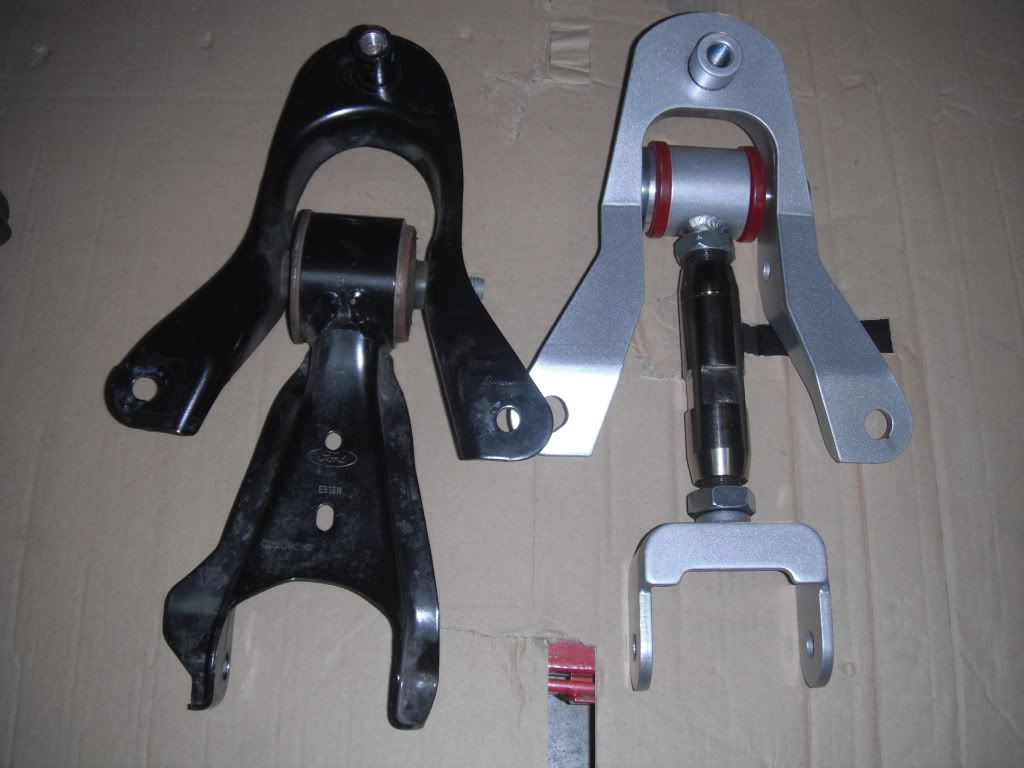
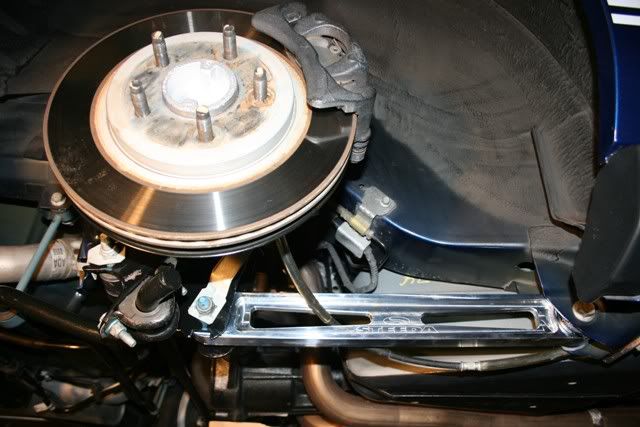
There are a number of manufacturers out there including BMR which I consider good products. I choose the Steeda since they have a race heritage and they had some features I wanted.
I have the competition UCA which is essentially longer for better geometry under load. It has the poly end bushing. I looked at the spherical ends in both metal and Teflon, but decided not to go with those. I did not want the metal due to the harshness and on going maintenance. I thought the Teflon to be too weak.
At the time when I changed out the control arms I did not change the axle housing bushing. My thought was this would keep things quieter and give some compliance to the UCA and allow the suspension to roll with out binding. I think that worked, but I had a very slight clunk when at low speed when on and off the throttle.
On the lower control arms I did go with the alum for the bling factor. I opted for the poly on one end and Teflon heim joint on the other. Again for the non binding features.
The mods did not really give me any notice ride noise, mainly because of the poly bushings on at least one end of the arms. And wheel hop was gone. That was my main objective.

New and old, longer UCA


thundr
Well-known member
Completed the install of the Steeda UCA and LCAs, set the pinion angle at 1 ¾ Deg. The LCA relocation brackets did not make it on the car. I will wait until I lower the car to do these. Want to make sure the wheel base is correct for the ride height. The LCA are non adjustable, so when the brackets get installed I will be able ensure they get welded in the right spot.
So with the stock springs the LCA angle is 0.5 Deg sloping up to the body from the axle, essentially flat.
The next project will be to lower the car. I read that folks are happy with the results of Ford Racing Parts springs. There seems to be ‘K’ and ‘L’ types. Type L for GT500 and type K for GT.
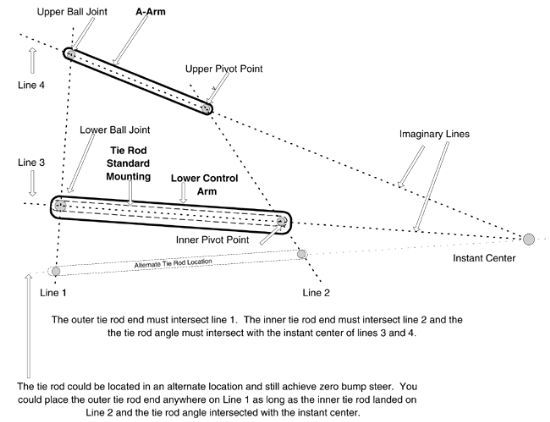
To do these adjustments the car has to be level and sitting on the wheels.So I built some ramps and four blocks of even height..

So with the stock springs the LCA angle is 0.5 Deg sloping up to the body from the axle, essentially flat.
The next project will be to lower the car. I read that folks are happy with the results of Ford Racing Parts springs. There seems to be ‘K’ and ‘L’ types. Type L for GT500 and type K for GT.

To do these adjustments the car has to be level and sitting on the wheels.So I built some ramps and four blocks of even height..

thundr
Well-known member
The next mod was to lower the car. I got a surprise here, after all the research I checked out I decided to go mild. This meant I was going for 1 ¼” drop, this was the FORD racing spec so I decided to go with those springs. The surprise was I didn’t get 1 ¼” drop equally all around. I got about 5/8” in the front and 1 ½” in the rear. As it ended up the car is more level and I did not have the steep rake that had the rear up quite high. So I was very happy with the stance.
Part of this mod was to install camber plates up front to correct any alignment and be able to dial in what I wanted.
Here’s a pic of the spring assemble, I did not change the struts.
Having already completed the rear control arms I was ready to adjust the pinion angle.
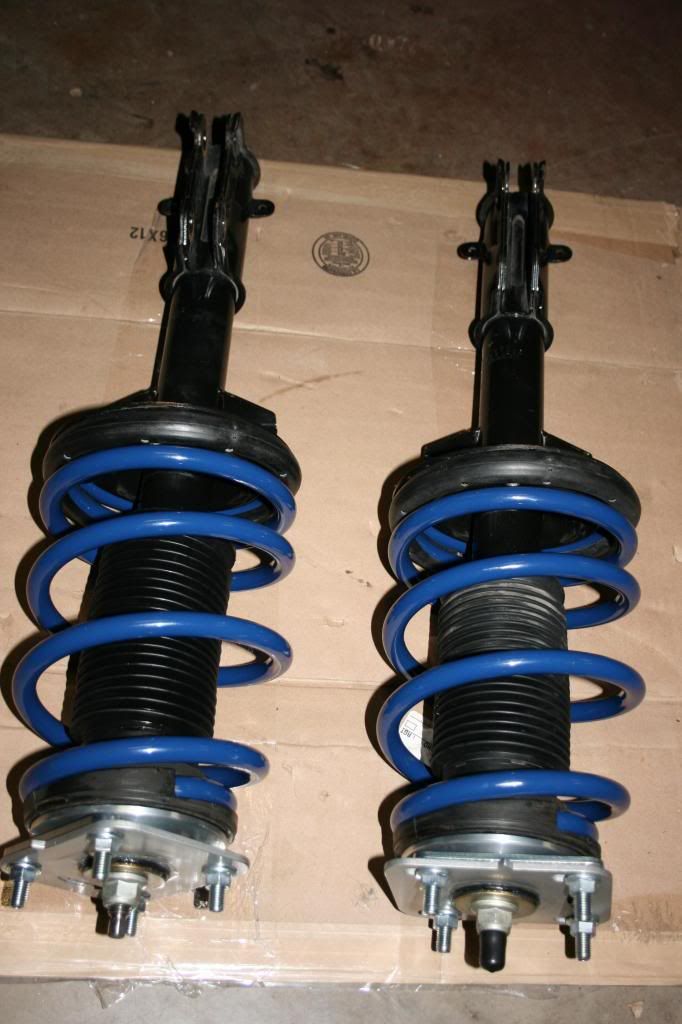

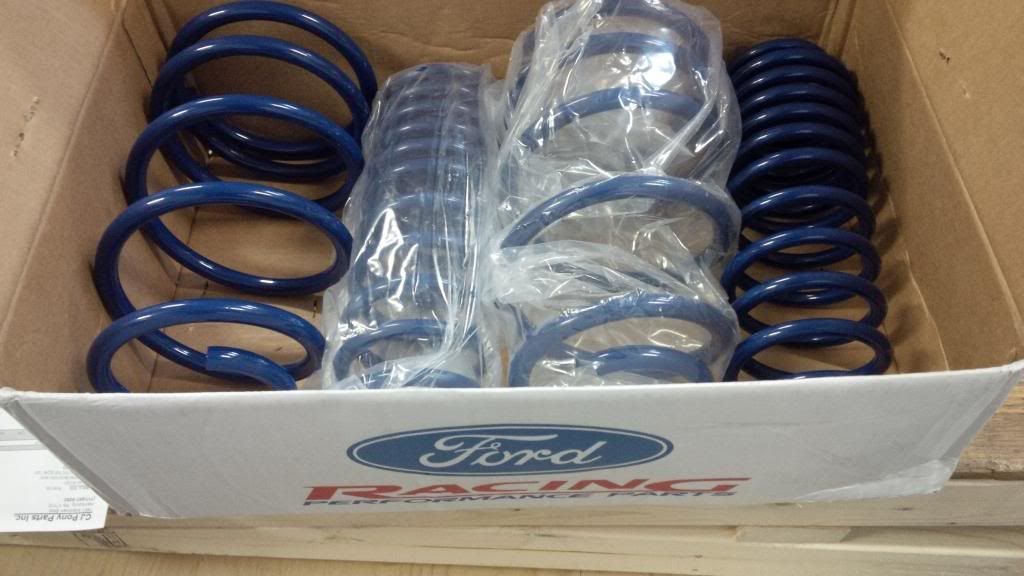
Part of this mod was to install camber plates up front to correct any alignment and be able to dial in what I wanted.
Here’s a pic of the spring assemble, I did not change the struts.
Having already completed the rear control arms I was ready to adjust the pinion angle.



05 gt 5spd
On the road again
You have got a great looking car, not much to change to make it look better. Nice choices on the handling mods.
I got the same height results from my spring change over, glad in the end that the rear dropped more.
I got the same height results from my spring change over, glad in the end that the rear dropped more.
thundr
Well-known member
I decided to install Relocation brackets on my car to adjust the LCA angle. Prior to dropping the car I had to change the pinion angle. But what about LCA relocation brackets? LCA brackets attach to your rear axle, at the rearmost end of the LCA. The typical relocation bracket has multiple different bolt holes that you can choose between, allowing you to choose what the angle of your LCAs and to compensate for the amount of drop.
The LCA angle is important because of what the LCAs do. The main job of the LCA is to transfer the force from your rear axle to the body of the car. They are literally what pushes your car forward when you accelerate. (The UCA contributes too, but to a lesser extent). The LCAs have a pivot at each end. This means that they cannot apply a torque or "twisting" force. They can only apply force in a straight line, along their length. You could not, for example, use an LCA as a wrench. But you could push against something with it.
When an 05+ Mustang rolls out the door at Ford's plant, the car is configured so the LCAs are basically parallel with the ground. They are horizontal. Thus, when the axle starts to push forward, the LCAs push along their length--horizontal--and they push the car straight forward. Makes sense, right?
So what happens if you change this angle? The most common case of this is if the car is lowered. When you lower the car you lower the car's body. But, the rear axle stays put. This has the effect of lowering the front of the LCA. Instead of being horizontal, the LCAs are now lower in the front and higher in the rear. When you accelerate, the LCAs push in a straight line, just as they always do. But now the straight line is angled downwards at the body connection of the LCA. This means that MOST of the force from the wheels is still pointing forward, but a portion of it is actively pushing the body of the car down towards the ground. Newton taught us that every action has an equal an opposite reaction. And it's this reaction that's bad. The reaction to the body being pressed down, is that the rear axle is being pressed UP. This force actively lifts the tires off the pavement....as if you had a big helium balloon tied to your axle. The harder you accelerate, the more your axle gets lifted up...and that costs you traction. A car that is lowered without LCA relocation brackets has LESS traction under acceleration than a stock-height car because of this! The angled LCA also causes a rougher ride.
LCA relocation brackets let you change the position of the rearmost end of the LCA. By switching them to a lower mounting position, we can restore the OEM horizontal configuration on a lowered car. That means you can have your car lowered, but without suffering the ill effects I just described.
But we can also change things to our advantage. If we lower the rear end of the LCA even more, so now it's lower in the rear than at the front, we get a similar situation to what I described above...but backwards. Now, the force from the rear axle is pushing up on the body. The reaction force pushes DOWN on the axle, planting it to the pavement. In this case the harder you accelerate, the more the tires are pressed onto the road...providing more traction. This is excellent for drag racing, and this kind of adjustment is key on all successful drag race vehicles. This is why all serious drag race cars run a multi-link rear suspension or ladder bars (if the rules allow it), because it enables better traction at launch.
Thus, using LCA relocation brackets lets you correct your LCA angle if you lower the car. They also give you the option of running an even more aggressive setting (lowered or not) which will enhance your traction at launch.
So for mine I wanted to get back to level as I have more interest in Road course type driving.
These are Steede weld in brackets, didn't want them coming loose.
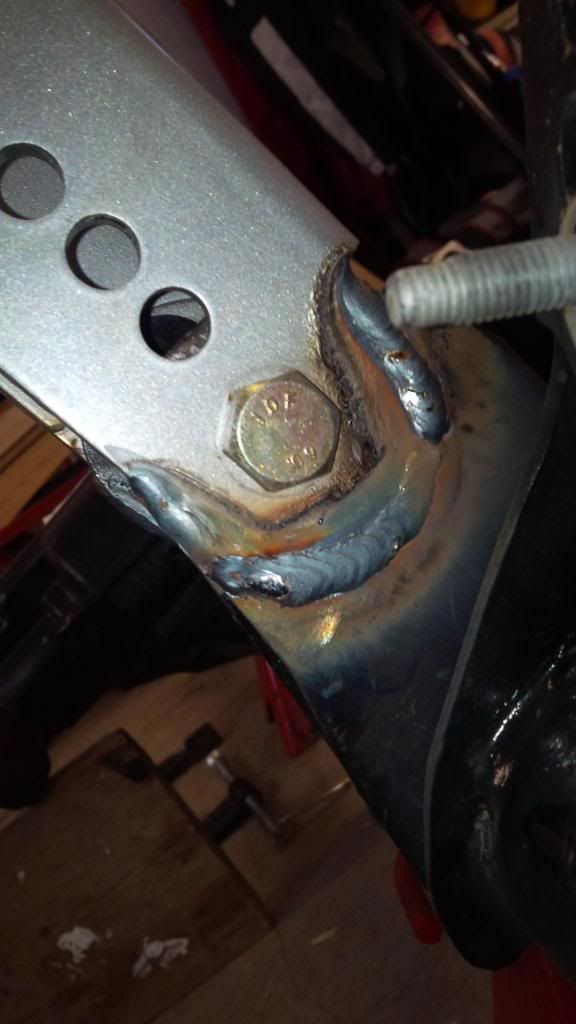
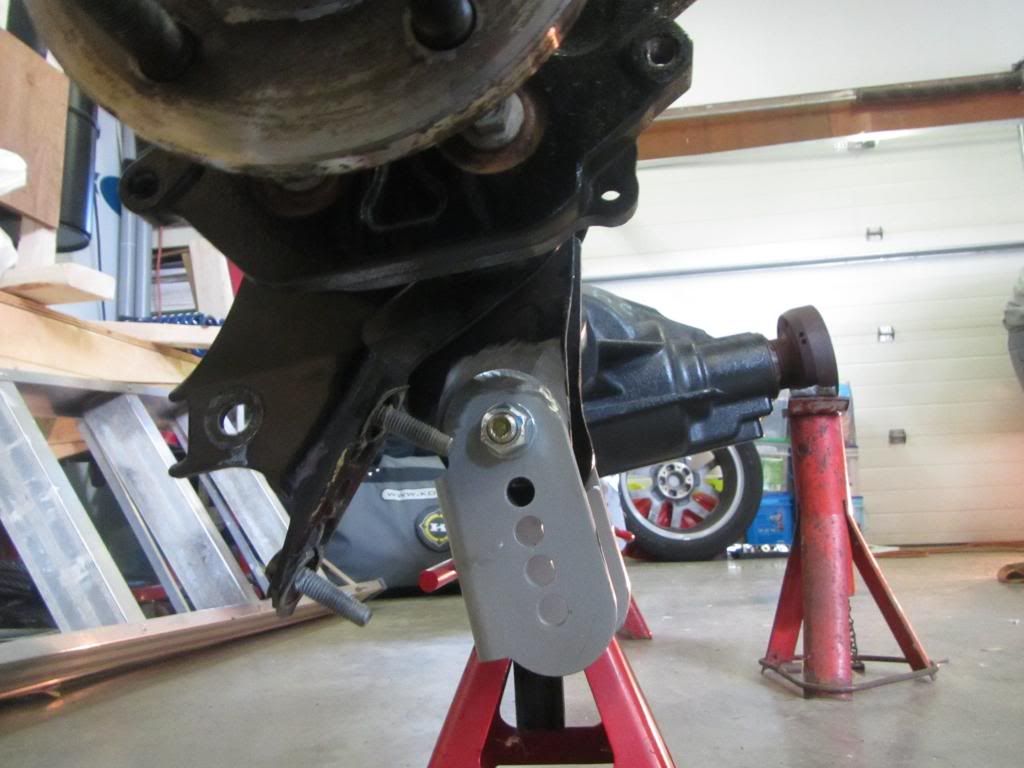
The early bolt on brackets did not fair well.
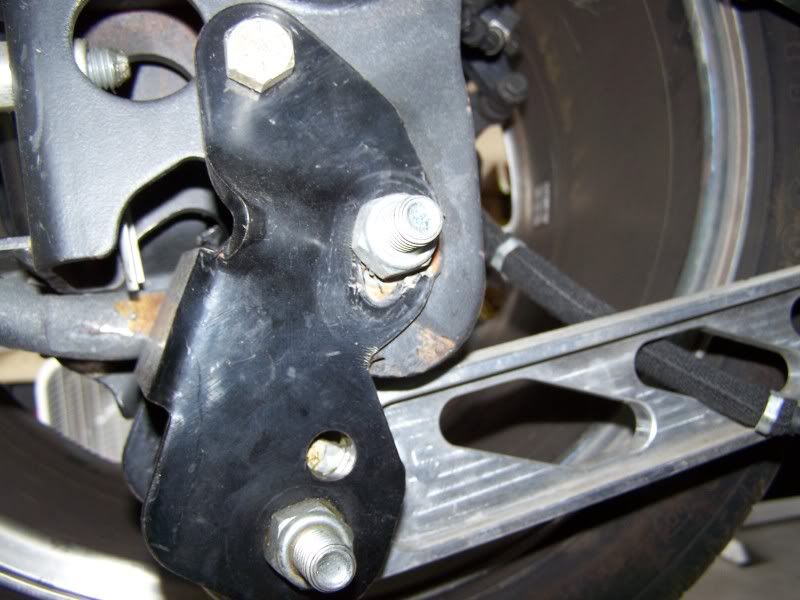
The LCA angle is important because of what the LCAs do. The main job of the LCA is to transfer the force from your rear axle to the body of the car. They are literally what pushes your car forward when you accelerate. (The UCA contributes too, but to a lesser extent). The LCAs have a pivot at each end. This means that they cannot apply a torque or "twisting" force. They can only apply force in a straight line, along their length. You could not, for example, use an LCA as a wrench. But you could push against something with it.
When an 05+ Mustang rolls out the door at Ford's plant, the car is configured so the LCAs are basically parallel with the ground. They are horizontal. Thus, when the axle starts to push forward, the LCAs push along their length--horizontal--and they push the car straight forward. Makes sense, right?
So what happens if you change this angle? The most common case of this is if the car is lowered. When you lower the car you lower the car's body. But, the rear axle stays put. This has the effect of lowering the front of the LCA. Instead of being horizontal, the LCAs are now lower in the front and higher in the rear. When you accelerate, the LCAs push in a straight line, just as they always do. But now the straight line is angled downwards at the body connection of the LCA. This means that MOST of the force from the wheels is still pointing forward, but a portion of it is actively pushing the body of the car down towards the ground. Newton taught us that every action has an equal an opposite reaction. And it's this reaction that's bad. The reaction to the body being pressed down, is that the rear axle is being pressed UP. This force actively lifts the tires off the pavement....as if you had a big helium balloon tied to your axle. The harder you accelerate, the more your axle gets lifted up...and that costs you traction. A car that is lowered without LCA relocation brackets has LESS traction under acceleration than a stock-height car because of this! The angled LCA also causes a rougher ride.
LCA relocation brackets let you change the position of the rearmost end of the LCA. By switching them to a lower mounting position, we can restore the OEM horizontal configuration on a lowered car. That means you can have your car lowered, but without suffering the ill effects I just described.
But we can also change things to our advantage. If we lower the rear end of the LCA even more, so now it's lower in the rear than at the front, we get a similar situation to what I described above...but backwards. Now, the force from the rear axle is pushing up on the body. The reaction force pushes DOWN on the axle, planting it to the pavement. In this case the harder you accelerate, the more the tires are pressed onto the road...providing more traction. This is excellent for drag racing, and this kind of adjustment is key on all successful drag race vehicles. This is why all serious drag race cars run a multi-link rear suspension or ladder bars (if the rules allow it), because it enables better traction at launch.
Thus, using LCA relocation brackets lets you correct your LCA angle if you lower the car. They also give you the option of running an even more aggressive setting (lowered or not) which will enhance your traction at launch.
So for mine I wanted to get back to level as I have more interest in Road course type driving.
These are Steede weld in brackets, didn't want them coming loose.


The early bolt on brackets did not fair well.

thundr
Well-known member
During the bracket assembly I decided to replace the top bushing for the UCA. Originally I was thinking the stock rubber bushing would be a little more compliant and have less NVH, so I left it in place. It would have been a real bitch to get out while the diff was still in the car. It was still a tough job to get out. So I bought a urethane bushing and installed it. Hers a a pic of the removal and a couple of the install.

